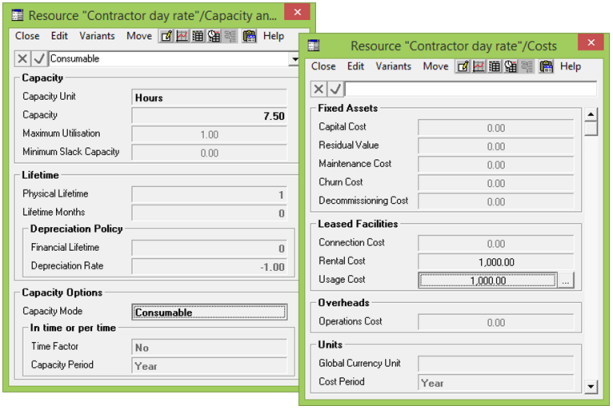Once you have an aggregate output from a transformation such as engineer hours in a given period, how can you then tell STEM that any associated costs should arise in that period only, and that these costs should be a function of the number of events rather than the length of the period?
The concept of a consumable resource was introduced in STEM 7.3. Its capacity is transient in the sense that it is ‘used up’ by aggregate demand in a period, as opposed to being persistent – like the number of ports on a switch – which provide capacity year after year. In simple terms, it only makes sense for an instantaneous demand to require persistent capacity, or for an aggregate demand to use up consumable capacity. (We will look at an exception to this rule – matching required power with consumed energy – later.)
A consumable resource is identified by changing a new input,
Capacity Mode, from the default Persistent to
Consumable. The lifetime for such a resource may be set to zero if its cost is generated solely within the current period, and it will have no concept of depreciation (but see 10.3.1.4 Working with stock of consumable resources with a ‘shelf life’). Any installed capacity is ‘used up’ by demand in the current period and the associated operating costs are generated on a one-off basis per unit of capacity as opposed to each period, per length of period, as they are for a conventional persistent resource:
-
Operations Cost
and Usage Cost
are generated in proportion to the actual capacity used up in a period
-
Maintenance Cost
and Rental Cost
are generated in proportion to the new capacity installed in a period (which will be the same as when it is used with a zero lifetime).
Thus, if ‘engineer hours’ is mapped onto a consumable resource representing the day rate of a contractor with a capacity of 7.5 hours, then
Operations Cost
and Usage Cost
would be appropriate if the booking was in proportion to actual hours, whereas
Maintenance Cost
or Rental Cost
would be generated in proportion to full days booked. The hours required in a period would ‘use up’ the contractor’s charged hours in that period, and fresh hours would be ‘installed’ in the next period as required.

Cost per day of a consumable resource meeting demand for engineer hours each period